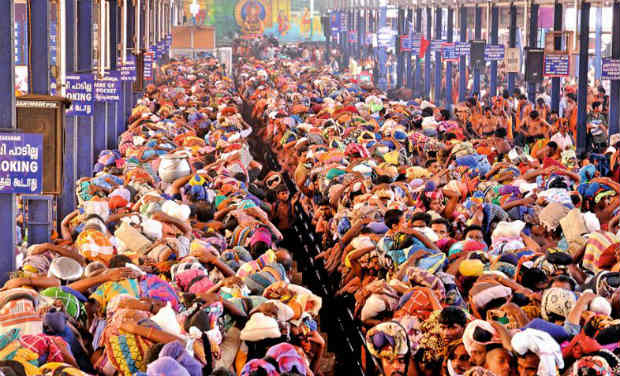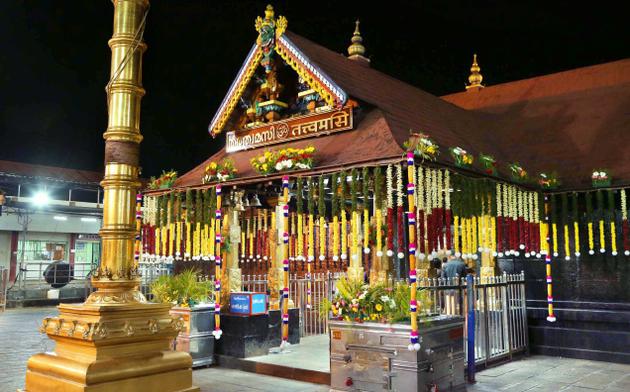The unique customs and traditions of Sabarimala
Sabarimala follows several unique traditions. Before visiting the temple, pilgrims are required to observe austerities for 41 days. They are required to take two baths a day (in the morning and in the evening before meals), sleep on mats or the bare floor, follow a strictly vegetarian diet and abstain from sex. Even indulging in sexual fantasies is prohibited during these days. They must not cut their nails or shave the hair on their head or face. They must refrain from using profanities and try to find God in everyone and everything. They are required to wear plain black or blue clothes. Some pilgrims also wear saffron. Some ardent devotees even refuse to wear footwear during these days of austerity. The family member who prepares the food for the pilgrim is required to have a bath before cooking food.

Devotees waiting in queue to obtain the darshan of Lord Ayyappa. Here everybody is equal before the God.
Performing the austerities prepares the devotees mentally and physically for the strenuous hike through the thick forests. Now the government has built several facilities along the forest path and the journey has become a whole lot easier and less dangerous.
While some despise the ‘development’ that made Ayyappan’s pookavanam (the dense jungle of flowers surrounding the temple), a concrete jungle, there are countless others who lament that the facilities are not enough. The truth is that each year the temple receives more devotees than it can possibly handle. The vast majority of them are lured by the hills and the opportunity of a communion with nature and one’s own self. When they see the transformation of Sabarimala from a hill shrine to a modern temple, they feel disappointed, but the government can’t shrug off its responsibility to build at least bare minimum facilities here. Over 100 million pilgrims visit the temple each season that lasts less than 60 days. This makes Sabarimala one of the busiest pilgrimage centers in the whole world. Earlier the path was merely a trail through the forest. Sabarimala is part of the Periyar Tiger Reserve and the journey through the forest used to be a dangerous one. Since the paths were strewn with stones and thorns, devotees were advised to walk barefoot during the 41 days. This kind of penance would harden their soles and made the journey less painful.

Tatwamasi – Thou Art That – You Are The Brahma
Sharam vili is an important part of the pilgrimage. Devotees sing hymns and prayers that celebrate the Lord and the journey while climbing the hills. One particularly popular line goes like this: kallum mullum kalukkumetha (the stones and thorns are like a bed to the feet) and kundum kuzhiyum paramanandham (the uneven and rough path is pure bliss). Not anymore. The government has built concrete roads through the forest. Devotees, especially old devotees, lament that Sabarimala is becoming a concrete jungle. I sympathize with him. I had an opportunity to visit the temple as a child about thirty years ago. The shrine was much less developed and ‘purer’ then, but you can’t blame the government. Each year there is a dramatic increase in the number of devotees and they should have at least basic facilities. Luckily the pilgrimage season lasts just two months and that gives the forests ample time to recover.
Pilgrims walk the entire distance from Pampa to Sannidhanam barefoot. Vehicles don’t go beyond Pampa. Earlier at least some devotees would cover the entire journey from their home to the temple on foot. This required them to start the pilgrimage several months in advance. Such practices are becoming rare now and most devotees reach Pampa in a vehicle and then walk the distance to Sannidhanam.
Here the devotee becomes one with the God
The person who observes the austerities for visiting Ayyappan’s temple is also addressed Ayyappan. This is the most unique aspect of Sabarimala pilgrimage. It culminates in the union of the God and His devotee. Both the god and his devotee are known by the same name – Ayyappan. Female devotees are called Malikappuram.
Malikappurathamma is the name of the Goddess installed outside the temple. In her previous life she was a bull headed demon called Mahishi. The sister of Mahishasur whom Goddess Durga killed, she vowed to wreak havoc on earth and avenge the murder of her brother. Legend has it that she observed severe austerities and won a boon that made her almost invincible. As per the boon that she received, she could only be killed by the son of Lord Vishnu (Hari) and Lord Shiva (Haran). The ‘clever’ Mahishi assumed that since both Vishnu and Shiva were males, they wouldn’t be able to beget a son. She was wrong. The very purpose of Ayyappa’s birth as Manikandan on this planet was to kill Mahishi.
The battle between them was fought on the banks of the river Azhutha. Mahishi was defeated and killed in the battle. Later Ayyappan resurrected her as a beautiful woman. Now a devotee of Ayyappan, Mahishi insisted that he should marry her. However, the Lord was wedded to the idea of celibacy and refused to fulfill her desire. He, however, gave her one promise. He promised her that he would marry her in that year when no kanni Ayyappan (a person who visits the hill shrine for the very first time) climbs the hills to reach his shrine. Every year, when the pilgrimage season begins Malikappurathamma anxiously waits to know if there are any Kanni Ayyappans. The tens of thousands of Kanni Ayyappans who reach the feet of Ayyappan every day of the season break her heart, but she blesses them all and the wait continues. A shrine is dedicated to her outside the Sannidhanam and she is revered as Malikappurathamma. Female devotees are addressed as Malikappuram in her honor.
The Sabarimala temple has a policy that prevents women aged between 10 and 50 from entering the temple. This is a centuries old practice that has been contested by several women’s activists. The Supreme Court verdict on this issue is being awaited.